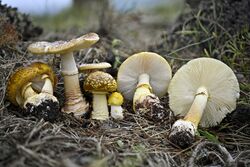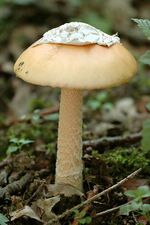Biology:Amanita augusta
| Amanita augusta | |
|---|---|

| |
| Amanita augusta in Pacifica, California | |
| Scientific classification | |
| Domain: | Eukaryota |
| Kingdom: | Fungi |
| Division: | Basidiomycota |
| Class: | Agaricomycetes |
| Order: | Agaricales |
| Family: | Amanitaceae |
| Genus: | Amanita |
| Species: | A. augusta
|
| Binomial name | |
| Amanita augusta Bojantchev & R.M.Davis (2013)
| |
| Synonyms | |
(1881) | |
| Amanita augusta | |
|---|---|
| Mycological characteristics | |
| gills on hymenium | |
| cap is convex | |
| hymenium is free | |
| stipe has a ring and volva | |
| spore print is white | |
| ecology is mycorrhizal | |
| edibility: inedible | |
Amanita augusta is a small tannish-brown mushroom with cap colors bright yellow to dark brown and various combinations of the two colors. The mushroom is often recognizable by the fragmented yellow remnants of the universal veil.[1] This mushroom grows year-round in the Pacific Northwest but fruiting tends to occur in late fall to mid-winter. The fungus grows in an ectomycorrhizal relationship with hardwoods and conifers often in mixed woodlands.[1]
Taxonomy
A. augusta is a species of agaric fungus in the family Amanitaceae. Found in the Pacific Northwest region of North America, it was initially referred to as Amanita franchetti (Boudier 1881) and later Amanita aspera (Thiers 1982, Arora 1986), but suspected of being a distinct species, It was formally described as Amanita augusta in 2013.[1]
Description
The cap of A. augusta ranges from 4–12 centimetres (1 1⁄2–4 1⁄2 inches) across with a plano-convex curve. The surface of the cap is smooth and ranges in various shades of brown. The surface also contains scattered yellow to brown colored warts formed from the remains of the universal veil. The flesh of the mushroom is soft and tends to be white to light yellow. The lamellae consists of close, white gills that are free or mildly attached to the upper stipe. The stipe ranges from 5–15 cm long and 1–2 cm thick. Most stipe contain a partial veil that resembles a secondary, smaller ring the same color as the cap. The surface of the stipe is white and scattered with occasional scales. Yellow to gray warts remnants of the universal veil on the basal bulb. The spores are elliptical, ranging from 8x12 - 6x8 µm and amyloid.[2] Clamps are not present at the base of basidia.[3] Like many other mushrooms of the Amanita genus, A. augusta contains a white spore print.[4]
Distribution and habitat
Amanita augusta is mycorrhizal with a range of trees in mixed woodlands. Usually found in small groups or alone. This mushroom is most commonly found in Northern and Central California. The fungus is also found along the Pacific Northwest and has been seen in Montana and Idaho.[2]
Ecology
This species forms ectomycorrhizal associations with conifers and a variety of other hardwoods such as oak, spruce, and Pinus species.[1] This species showed a poor survival rate and is a very slow re-colonizer post controlled burn of host trees.[5] When the fungi reappear and grow mycorrhizae, they form small communities rather than grow in a large group.[6] Two of the most established hosts of A. augusta are P. muricata and Ps. menziesii.[1]
Toxicity
Amanita augusta is classified as a non-edible fungus. This mushroom is known to be an accumulator of heavy metals such as zinc, copper, lead, and others found in soil.[7] The metals are mostly found in the cap and accumulate in the sporocarps but the stipe also contains the heavy metals. Many of the wild A. augusta contain levels of heavy metals above the threshold for safe human consumption.[7] This mushroom's ability to accumulate heavy metals more effectively than others is most likely attributed to the ectomycorrhizal associations which allow them to be more efficient in the uptake of metals.[7] One of the most common metals found in this mushroom is zinc.[8]
Uses
Amanita augusta was found to have strong anti-proliferative activity and could be a potential source for drug discovery. Toxicity testing would need to be done within the mushroom in order to ensure that the medicinal properties are not negated by harmful side effects.[9] Along with being a strong anti-proliferative, this species is also shown to be anti-inflammatory and immunostimulatory as well,[10] meaning there may be many possible opportunities for drugs.
See also
References
- ↑ 1.0 1.1 1.2 1.3 1.4 Bojantchev D, Davis RM. (2013). "Amanita augusta, a new species from California and the Pacific Northwest". North American Fungi 8 (5): 1–11. doi:10.2509/naf2013.008.005.
- ↑ 2.0 2.1 Stevens, Michael Wood & Fred. "California Fungi: Amanita augusta". http://www.mykoweb.com/CAF/species/Amanita_augusta.html.
- ↑ "Amanita augusta - Amanitaceae.org - Taxonomy and Morphology of Amanita and Limacella". http://www.amanitaceae.org/?Amanita%20augusta.
- ↑ Oda, Takashi; Tanaka, Chihiro; Tsuda, Mitsuya (February 2002). "Amanita concentrica : a new species in Amanita section Amanita from Japan". Mycoscience 43 (1): 81–83. doi:10.1007/s102670200013. ISSN 1340-3540. http://dx.doi.org/10.1007/s102670200013.
- ↑ Bruns, Tom; Tan, Jenny; Bidartondo, Martin; Szaro, Tim; Redecker, Dirk (September 2002). "Survival of Suillus pungens and Amanita francheti ectomycorrhizal genets was rare or absent after a stand‐replacing wildfire" (in en). New Phytologist 155 (3): 517–523. doi:10.1046/j.1469-8137.2002.00468.x. ISSN 0028-646X. PMID 33873313.
- ↑ Redecker, Dirk; Szaro, Timothy M.; Bowman, Ryan J.; Bruns, Thomas D. (April 2001). "Small genets of Lactarius xanthogalactus , Russula cremoricolor and Amanita francheti in late-stage ectomycorrhizal successions: genet size of ectomycorrhizal fungi" (in en). Molecular Ecology 10 (4): 1025–1034. doi:10.1046/j.1365-294X.2001.01230.x. PMID 11348508. http://doi.wiley.com/10.1046/j.1365-294X.2001.01230.x.
- ↑ 7.0 7.1 7.2 Lalotra, P (2016). "Bioaccumulation of heavy metals in the sporocarps of some wild mushrooms". Current Research in Environmental & Applied Mycology 6 (3): 159–165. doi:10.5943/cream/6/3/2. http://www.creamjournal.org/pdf/Cream_6_3_2.pdf.
- ↑ Ouzouni, Paraskevi K.; Veltsistas, Panayotis G.; Paleologos, Evangelos K.; Riganakos, Kyriakos A. (2007-09-01). "Determination of metal content in wild edible mushroom species from regions of Greece" (in en). Journal of Food Composition and Analysis 20 (6): 480–486. doi:10.1016/j.jfca.2007.02.008. ISSN 0889-1575. https://www.sciencedirect.com/science/article/pii/S0889157507000385.
- ↑ Zeb, Mehreen; Lee, Chow H. (January 2021). "Medicinal Properties and Bioactive Compounds from Wild Mushrooms Native to North America" (in en). Molecules 26 (2): 251. doi:10.3390/molecules26020251. ISSN 1420-3049. PMID 33419035.
- ↑ Deo, Gurbind S.; Khatra, Jatinder; Buttar, Sukhpreet; Li, Wai Ming; Tackaberry, Linda E.; Massicotte, Hugues B.; Egger, Keith N.; Reimer, Kerry et al. (2019). "Antiproliferative, Immunostimulatory, and Anti-Inflammatory Activities of Extracts Derived from Mushrooms Collected in Haida Gwaii, British Columbia (Canada)" (in en). International Journal of Medicinal Mushrooms 21 (7): 629–643. doi:10.1615/IntJMedMushrooms.2019031193. ISSN 1521-9437. PMID 31679298. http://www.dl.begellhouse.com/journals/708ae68d64b17c52,4889d09f58e41d3c,5e7bc0a0616ba6e0.html.
Wikidata ☰ Q15093683 entry
 |


